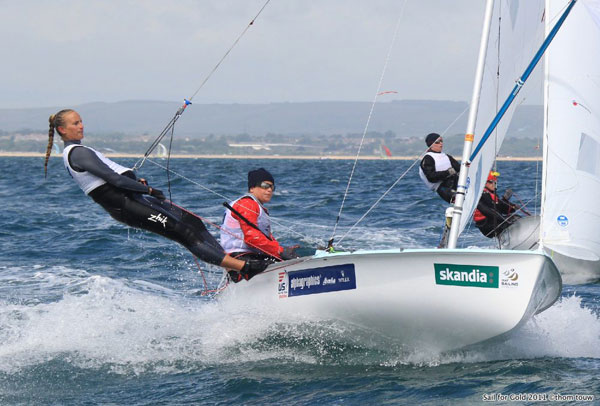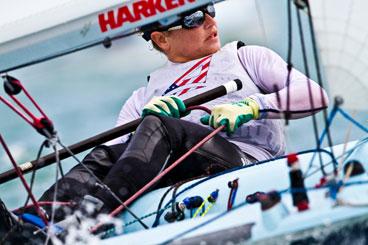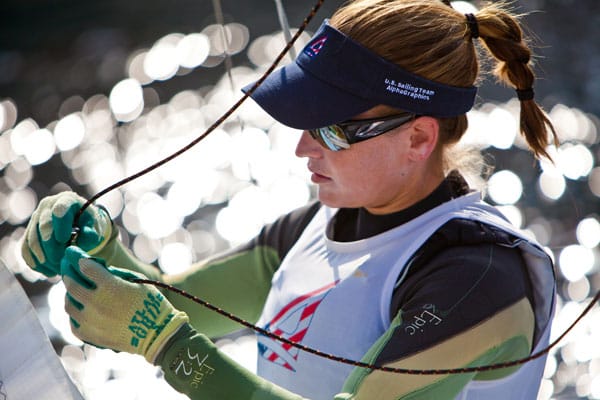
No Stranger to the Grind Image
Amanda Clark, one of the top women’s 470 skippers in the world, has just started talking about boatwork when her husband, Greg Nissen, files an objection. Nissen is the director of Camp Quinipet, a bucolic retreat and youth camp on the northwest corner of Shelter Island, N.Y. One of his annual fall tasks is to patch up the camp’s aging fleet of sailboats. “For me,” he says, leaning back in his chair in the cozy one-floor house afforded the camp’s top dog, “boatwork is a big tub of epoxy and a trowel.
“For you girls, boatwork is walking around your boat in a bikini and discussing whether this cleat or that cleat should be moved 5 mm to the left or right. You can do a day of ‘boatwork’ without taking the cover off the boat.” Then he laughs, as do Clark and Sarah Lihan, her crew. There is apparently at least a little truth to his statement.
However, the fact is that few people know the value of hard work—on boats or otherwise—better than Clark. From an age when most kids struggle to describe a “blue collar work ethic,” Clark has embodied it.
She’s not yet 30, but has spent nearly half her life on the U.S. Sailing Team, 14 years in pursuit of that elusive hunk of metal that can define, in one bold stroke, an athletic career.
Just as with any individual sport, getting to an Olympic regatta is largely a solitary pursuit. Coaches and partners will come and go. Parents can only push someone so far. Without the relentless drive to work at it year in and year out, you will fall short. It took Clark 10 years to make her first Olympic team: a decade of sailing, and of fund-raising the hundreds of thousands of dollars required.
She walked in the opening ceremony at the Beijing National Stadium; she got her picture taken with Kobe Bryant. She had an Olympic experience. But she came home without a medal. She wants another chance. She wants to compete in Weymouth, England, next summer. That will take more hard work. Despite all her accolades, she and Lihan are facing an uphill battle to earn a chance to compete on dinghy sailing’s biggest stage.
A true harelegger—so named because of the foot speed needed to catch the ferries that are the only way on or off Shelter Island—needs to be born on island. Amanda Clark doesn’t qualify since she was born at nearby Southampton Hospital. But she’s never really lived anywhere else, and her roots run back to a paternal great-grandfather, who moved to Shelter Island to care take a private estate on what is now the Mashomack Nature Preserve. The diminutive Clark, who is disarmingly youthful even at 29, followed her older siblings onto the water. Her brother and sister left the sport for greener pastures—horseback riding, and soccer and lacrosse, respectively—but she was hooked. As soon as she was able, she would spend most of her free time sailing her Optimist out of the Shelter Island YC. Initially her dad would keep watch, pantomiming the competition in a small motorboat. “I don’t think I ever beat him,” Clark recalls with a smile. As a pre-teen, she would venture out on her own. She’d pack a sandwich, bike from her childhood home to the yacht club, launch her boat, and point her bow west or east, always sailing up current first. She’d stop for lunch on some remote beach—using her bailer as an anchor so she didn’t scratch the bottom of her boat—and then sail home.
“Amanda, from very early, was very self-sufficient,” says Ellen Clark, her mother. “She had to tie her shoes before any of [her peers], swim before any of the others. She thought nothing of putting a lot of hours out practicing in her Opti. She loved it, and she thrived.”
This passion quickly matured into an intense, and enduring, competitive fire. She wasn’t halfway through high school before she set her sights on the 2000 Olympics, making the U.S. Sailing Team in the Europe Dinghy at the age of 15, the youngest female ever to do so.
“[High-school sailing] just wasn’t enough,” says Ellen Clark. “She’d sailed against all these European sailors before, and they were doing the Europe dinghy [and aiming toward the Olympics].”

Amory Ross
The 2000 U.S. Olympic Trials in the Europe class were an eye opener for Clark. She had a front-row seat for the pitched battle, on and off the water, between Meg Gaillard, the top U.S. sailor in the class, and Courtenay Becker-Dey, the 1996 Olympic bronze medalist who’d returned to the singlehander after missing selection in the 470 six months earlier.
The latter’s mental toughness won her that regatta—and the Olympic berth—and it showed Clark, who finished third, what was required to win at that level.First, though, she had to come to terms with fact that, at 5’3″, she was too short to sail the Europe. Prodded by coach Larry Suter, Clark switched to the 470. She was a quick study, finishing third in her first regatta, the 2001 Rolex Miami OCR.
She eventually settled on Sarah Mergenthaler as her crew. Mergenthaler was a multisport star at the University of Richmond: track and soccer. Sailing had been her social sport. But she, like Amanda, was intensely competitive.
Together the two climbed the 470’s steep learning curve, becoming one of the top teams in the United States and the world. At the 2003 U.S. Olympic Trials on Galveston Bay, they finished second to Katie McDowell and Isabelle Kinsolving.
“That’s one of the first times I’ve ever seen Amanda break down,” says Ellen Clark. “I ran out up to my knees in the water [to meet the boat]. She was just sobbing. That’s not Amanda at all. Hence why she went again.”
While back home decompressing after the Olympic Trials, Amanda Clark started spending a lot of time with Nissen, who’d come to Shelter Island to work at Camp Quinipet.
Nissen jokes that they caught each other during dual moments of weakness—Nissen had just quit a job he didn’t like—but his laid-back attitude is the perfect foil for his wife’s competitiveness.
The fact that she now lives at Camp Quinipet, just a few miles from her childhood home, makes Clark laugh. She came to the camp a few times in her youth. “I didn’t like it,” she says. “My memories are of damp concrete and spiders.” Her childhood dreams had her a long way from Shelter Island.
“I figured I’d marry a foreigner,” she says, “and live abroad for a while.”
But she draws strength from her home island. Shelter Island YC is always her first stop when she starts fund-raising. Clark is conscious of leaning too much on the Shelter Island community. But Cliff Clark, no relation, whose family has owned the South Ferry since 1714, says she shouldn’t worry.
“She’ll do everything she can on her own,” says Clark, a former Olympic-caliber distance runner, “and she would never ask for something unless she really needed it. I’ve never heard a person indicate they were weary of the number of the years she’s spent trying to make the Olympic team.”
Clark and Mergenthaler were back on the campaign trail in 2005. They handily won the U.S. Olympic Trials in 2007. At the 2008 Olympics, they were 12th. It was disappointing, though they were not a medal favorite.

Amory Ross/US Sailing
In 2009, Clark took her first extended break from Olympic-class sailing. But she kept her equipment. Clark’s usual fallback career was to work with her mother, who runs an executive search company. But she wanted to try something different, so she got a job on the shop floor at Wooden Boat Works in Greenport, N.Y.
“She was stellar,” says co-owner Donn Costanzo. “I don’t think I’ve ever seen anyone work at a such a pace. The nice thing about Amanda is a lot of people can work hard, but she worked intelligently.
“Everybody just adored her. She knows how to have a good laugh, knows when to crack a joke. You can take instruction from her.”
A late-season lap around Shelter Island in the 2009 Whitebread Race showed Costanzo, however, that her focus was still set on the Olympics. “There wasn’t one second that Amanda wasn’t telling somebody what to do or doing it herself,” he says. “She wouldn’t give us time to eat. It was follow the leader. Everybody started paying attention. We’d never seen anybody in such command.”
She and Mergenthaler returned to the campaign trail at the start of the 2010 season. It didn’t take long for them to regain their form. By May, they were the top-ranked American team. By August, they were eighth in the world.
But Mergenthaler’s heart wasn’t in another three-year commitment. After the Rolex Miami OCR in January, she left the campaign. “I was ready to start another chapter of my life,” she says. Thinking about sailing the 470 with Clark, however, still brings tears to her eyes.
With the benefit of hindsight, Clark says she never seriously doubted whether she would continue. Her mother, however, says it was a low moment.
“She has tremendous insight and calm,” says Ellen Clark, “but there are times when she’s still a young kid. The change of crew was extremely difficult, and there were times when she was going to quit.”
Instead, however, she went to work. She trialed three different crews before settling on Sarah Lihan, who herself was facing the difficult task of beating former Laser Radial world champion Paige Railey for the U.S. Olympic berth in that class. Lihan had no significant trapeze or spinnaker experience, and had never really been a crew. But she is young and talented. She also has something that can’t be taught: at 6’1″—7 inches taller than Mergenthaler—Lihan is the prototypical size for a 470 crew.
thought it was someone asking to get help loading a container,” says Lihan, a native of Fort Lauderdale, Fla., of the initial call from Clark. “I had my Laser training starting in three days. I said, ‘Can you get here tomorrow?’ And she did. It never felt like a tryout to me. As clueless and totally overwhelmed as I was when I came into the 470 boatpark, as soon as we got into the boat, it was a very nurturing experience. There’s no way I would’ve been able to do it had she not been such a great teacher.”
The Skandia Sail For Gold Regatta, which was the first of two events being used by US SAILING to select the Olympic team, was in four months, and Clark and Lihan were starting from scratch.
Simply getting the 470 around the racecourse wasn’t going to cut it. The other top U.S. team, Erin Maxwell and Kinsolving, have been sailing together since 2005, not long after Kinsolving finished fifth in the 2004 Olympics in Athens. In January 2008, just a few months after finishing second at the 2007 U.S. Olympic Trials, Maxwell and Kinsolving won the Women’s 470 World Championship.
“Sarah’s just as much of a perfectionist,” says Clark, of Lihan. “I could see it right away that she had the same drive to perfect her skill of sailing. She’s very quick to pick up the process, then move forward and make it her own. We’re moving forward at such a quick rate together because she learns and takes on the information so well.”
At Clark and Lihan’s first regatta, the Princess Sofia in Palma, Spain, in March, they finished 19th while Maxwell and Kinsolving scored a fifth. At Hyères Week, a month later, Maxwell and Kinsolving were seventh, Clark and Lihan, 33rd. A similar disparity in the results at the Sail For Gold regatta would effectively end their Olympic hopes.
“They’re a very strong team,” says Clark. “We needed to keep [the difference between the two teams’ overall finishes] inside of 10 points.”
Maxwell and Kinsolving started strong at Sail For Gold and were leading the regatta after two races. But by the end there were just three places between the two teams: Maxwell and Kinsolving finished eighth, with Clark and Lihan in 11th.
“We put it together right before Sail for Gold,” says Clark. “We said, ‘We’re not going to try to learn anything new, let’s race with what we have and then take then next step after the regatta.’”
A month after Sail For Gold, Clark and Lihan beat Maxwell and Kinsolving for the first time, finishing eighth to their ninth at the 470 Women’s European Championships.
But that is still two places shy of the gap that Clark and Lihan will need at December’s ISAF World Championships in Perth, Australia, which is the second half of the U.S. Trials. At the business end of the women’s 470 fleet, two spots can only be earned with a lot of hard work. And Maxwell and Kinsolving will be working just as hard to maintain their advantage.
“I sailed Lasers for 12 years,” says Lihan. “In college, the doublehanded scene is a very different relationship, power and decision-making wise, than it is in the 470. It’s going to become one of our greatest strengths, when we can utilize each other’s skills around the racecourse.”
“Then it’s the little things,” adds Clark. “Really the same stuff I was working on with old Sarah, the stuff that never goes away. Getting better at tacking, at jibing.
“It’s one thing to get it right in practice; it’s another to get it right during a race when you’ve got a boat coming at you.”
Having closed a seemingly unbridgeable gap in a few months, it would be easy to say that the hard part is behind Clark and Lihan. But on the Olympic road, the hardest part is always ahead.









